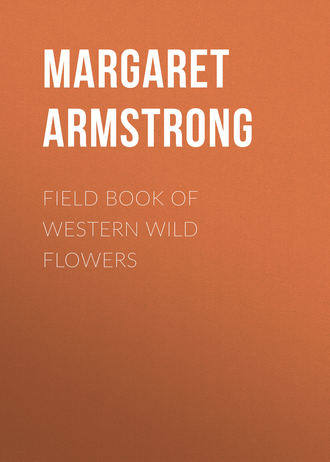 полная версия
полная версияField Book of Western Wild Flowers
Monkey-flower
Mímulus brévipes
YellowSpring
California
A very handsome plant, from one to two feet high, rather hairy and sticky all over, with dark green leaves, usually toothless, and large, clear bright yellow flowers, an inch and a half long, with a pair of ridges in the throat and a pale green stigma. This grows on hillsides, the rich green foliage and bronze-colored buds contrasting finely with the bright flowers. The leaves are quite unlike those of the Common Yellow Monkey-flower.
Pink Monkey-flower
Mímulus Lewísii
Pink
Spring, summer
West, etc.
A graceful mountain perennial, growing near streams, from two to three feet tall, with bright green, toothed leaves, thin in texture, more or less hairy, without leafstalks; the stems and buds slightly sticky. The lovely flowers are nearly two inches long, the corolla varying from pale pink to rose-red, with two, hairy, yellow ridges in the throat, the stamens not protruding from the tube. This pink kind takes the place in the high mountains of the Scarlet Monkey-flower of lower altitudes and is found as far east as Colorado.
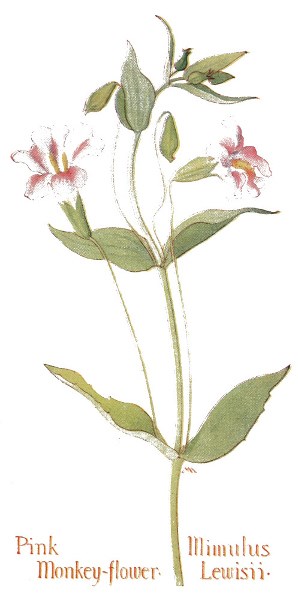
Pink Monkey-flower – Mimulus Lewisii.
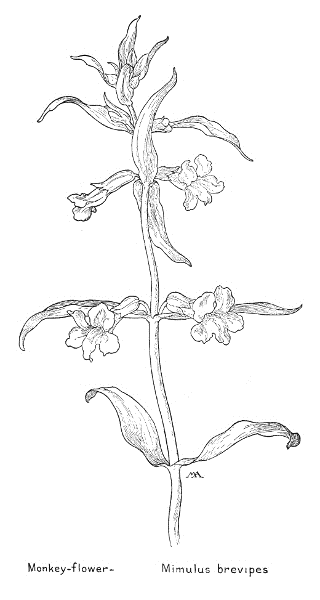
Monkey-flower – Mimulus brevipes.
Scarlet Monkey-flower
Mímulus cardinàlis
Red
Spring, summer
Southwest. Oreg.
An exceedingly handsome kind, sometimes nearly five feet high, much like the last, but with vivid scarlet corollas, decidedly two-lipped, the upper lip erect and the lower lobes turned back, the stamens protruding from the tube. I first saw these gorgeous flowers glowing like bits of flame among the ferns and grasses that bordered a beautiful spring in a cave in the Grand Canyon, where icy water fell on them drop by drop through a crevice in the rocky roof far above them and kept them glistening with moisture. This is often cultivated in gardens.
Little Yellow Monkey-flower
Mímulus primuloìdes
Yellow
SummerCal., Oreg.
A charming little plant, from three to six inches tall, with pretty delicate flowers, from half an inch to an inch long, the corolla-lobes all alike, bright yellow, often dotted with crimson, growing singly on the tips of very slender flower-stalks, springing from a cluster of bright yellowish-green leaves, usually toothed, smooth, or sometimes hairy. This grows in moist mountain meadows.
Little Pink Monkey-flower
Mímulus Tórreyi
Pink
Summer
California
A delicate little plant, from three inches to a foot high, rather hairy and sticky, with very slender branching stems, yellowish-green, toothless leaves, and bright flowers, about three-quarters of an inch long, with almost no flower-stalks; the corolla-lobes pink, veined with purple, the tube crimson, with two yellow ridges in the throat. A patch of these little flowers scattered over a sandy slope in Yosemite, sometimes growing with a tiny blue and white Lupine that likes the same sort of place, is an exceedingly pretty sight. It grows in the mountains, preferring moderate altitudes, becoming lower and deeper in color in higher places.
Desert Monkey-flower
Mímulus Fremóntii
Pink
Spring
California
A charming little plant, something like the last but prettier, three or four inches tall, with very slender, stiff, purplish, branching stems and smooth, thickish, light green leaves, purplish on the under side. The flowers are nearly an inch across, with a hairy calyx and bright purplish-pink corolla, streaked with magenta, with yellow ridges on the lower lip and plaits inside the throat. They look exceedingly pretty on the pale sand of the Mojave Desert.
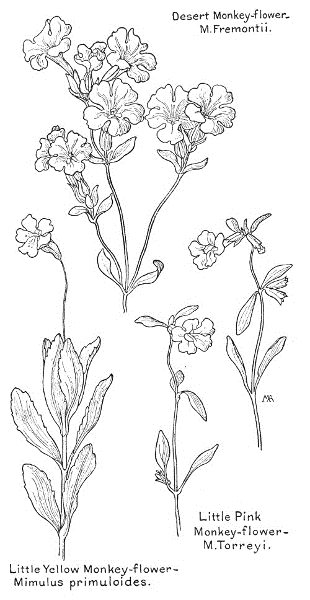
Desert Monkey-flower – M. Fremontii.
Little Pink Monkey-flower – M. Torreyi.
Little Yellow Monkey-flower – Mimulus primuloides.
Common Yellow Monkey-flower
Mímulus Langsdórfii
Yellow
Spring, summer
Southwest, Utah, etc.
There are several varieties of this common and attractive plant, some tall and robust, others very short. The stems are smooth, not sticky, thickish and pale, sometimes branching, about a foot tall, and the leaves are from one to three inches long, smooth, or slightly downy, especially on the under side of the upper leaves, and usually bright green, the veins prominent on the back, the upper leaves without leaf-stalks and more or less clasping, the lower ones with leaf-stalks varying in length. The flowers are from three-quarters of an inch to two inches long, clear bright yellow, the throat nearly closed and hairy, usually with some dark red dots between the hairy ridges on the lower lip. This grows in wet places in the mountains and in canyons, is widely distributed in the West, and has now strayed as far east as Connecticut.
Musk-plant
Mímulus moschàtus
Yellow
Spring, summer
West, etc.
This plant is more or less hairy and seems to be wet all over with slimy dew and smells of musk. When the stems are cut and put in water a slimy sort of mucilage drips from them. It is about ten inches tall, with rather pretty yellow flowers, barely an inch long, with some hairs and reddish specks in the throat. This is widely distributed, in wet places, from Ontario westward.
There are numerous kinds of Orthocarpus, many of them Californian, difficult to distinguish. Like Castilleja, their upper leaves often pass into colored bracts and the calyx is colored, but the corolla is not similar, for the upper lip is small and the three-lobed lower lip is swollen and conspicuous; calyx short, four-cleft; stamens four, two of them short, enclosed in the upper lip; style long, with a round-top stigma; leaves without leaf-stalks, usually alternate, often cut into three to five narrow divisions; fruit an oblong capsule with many seeds. Perhaps it is called Owl's-clover because, in some kinds, the flowers look like the faces of owls.
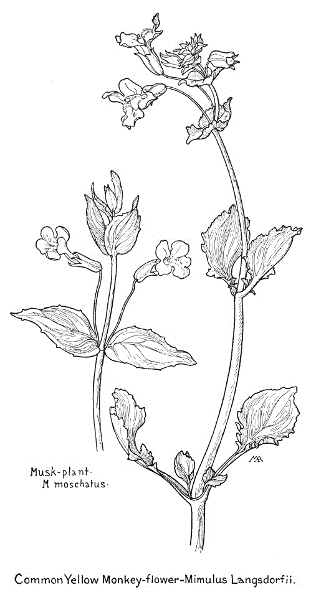
Musk-plant – M. moschatus.
Common Yellow Monkey-flower – Mimulus Langsdorfii.
Yellow Pelican Flower
Orthocàrpus faucibarbàtus
Yellow, whitish
Spring
California
One of the handsomest of its kind, a fine thrifty plant, but not at all coarse, and much prettier and more effective than the next. The branching stem is about a foot tall, and the leaves are very light, bright yellowish-green, and thin in texture. The flowers are about an inch long, with very clear bright yellow "pouches" and greenish "beaks" tipped with white. They have a curiously solid appearance, as if carved out of yellow wax, and are very pleasing and fresh in color, harmonizing well with the light green bracts, which give a very feathery effect to the top of the cluster. Like most of its relations, the flowers are more effective when we look down on them, growing among the grass, than when they are picked and we see them in profile. The corollas are sometimes pinkish-white. This is common in the valleys of the Coast Ranges.
Johnny-tuck
Orthocàrpus eriánthus
Yellow
Spring
Cal., Oreg.
From five to ten inches tall, with a slender, downy, purplish stem, often branching, dull green, downy leaves and purplish-tipped bracts. The sulphur-yellow flowers are usually an inch long, with a magenta "beak" and a very slender, white tube. They are pretty and very common on plains.
Pink Johnny-tuck, Pink Popcorn Flower
Orthocàrpus eriánthus var. rosèus
Pink
Spring
California
A delicate little plant, from five to ten inches tall, with a slender, downy, reddish stem, hairy, dull green leaves and bracts, and very pretty little flowers, nearly an inch long; the corollas varying from almost white to bright pink, but all the same shade on one plant, with a little yellow at the center and a maroon-colored "beak." They are deliciously sweet-scented, like violets, and grow in dry places. The variety versícolor, Popcorn Beauty, has fragrant white flowers.
Yellow Owl's Clover
Orthocàrpus lùteus
Yellow
Summer
West, etc.
This often makes patches of bright color. It is from six to twelve inches tall, with stiff, slender, hairy stems, hairy leaves, and pretty bright yellow flowers, nearly half an inch long. This grows in dry sunny places as far east as Colorado, reaching an altitude of ten thousand feet.
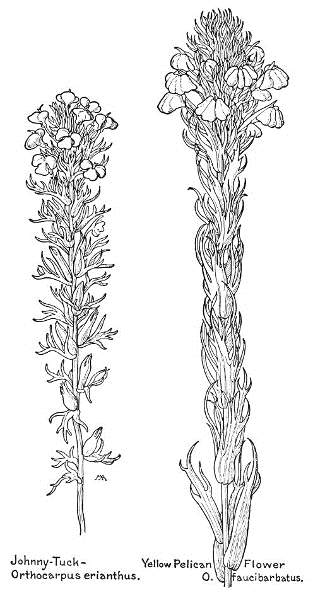
Johnny-Tuck – Orthocarpus erianthus.
Yellow Pelican Flower – O. faucibarbatus.
Escobita, Owl's Clover
Orthocàrpus densiflòrus
Purplish-pink
Spring
California
The Spanish name, which means "little broom," is very appropriate for this pretty plant. The stiff, downy stem is from five to fifteen inches tall and the downy leaves are light green and become tipped with purplish-pink as they mount up the stalk. The flowers are about three-quarters of an inch long and have a white lower lip, which is tipped with yellow and has a crimson dot on each lobe, and the straight, erect "beak" is crimson. The cluster is crowded with purplish-pink and white bracts and though the flowers themselves are not conspicuous the effect is feathery and very pretty, especially when the plants grow in such quantities as to color a whole field with soft pink, or when mixed with beautifully contrasting patches of blue Lupine. This is common along the coast. O. purpuráscens, common in the Northwest and Southwest, is similar, but it has a hairy "beak," hooked at the tip, and the general effect is handsomer and much brighter in color, but less feathery.
Owl's Clover
Orthocàrpus purpureo-álbus
Pink and White
Summer
Ariz., Utah, New Mex.
An interesting annual plant, quite pretty, about a foot high, the stem sometimes branching and the branches suggesting those of a candelabrum, clothed with soft, finely divided, dull green leaves and ending in spikes of green bracts and pretty little flowers, three-quarters of an inch long. The calyx is green, the upper lip of the corolla is purplish-pink and the lower lip is swollen, three-lobed and cream-white, turning pink in fading. This grows in dry places at altitudes of from six to eight thousand feet. Only one of the branches is given in the picture.
Owl's Clover
Orthocàrpus exsértus
White and pink
Spring, summer
California
A pretty little plant, from six to eight inches high, with hairy leaves cut into narrow divisions and passing into pinkish-lilac bracts towards the top of the stalk, which are mixed with pink and white flowers, each about an inch long, so that the effect of the whole is a spike of pink and white. The lower lip of the corolla is white and the upper lip is pink, with a furry tip. This grows in fields. O. attenuàtus, common in fields in the Northwest, is a slender inconspicuous kind, about nine inches tall, with soft, thin, dull green leaves, most of them not lobed, and pale green bracts, often tipped with white. The corollas are dull white, the lower lip dotted with purple or yellow, and the whole effect of the cluster is feathery, very slender, and pale in color.
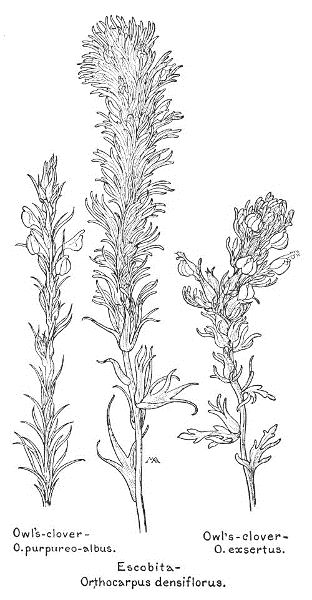
Owl's-clover – O. purpureo-albus.
Escobita – Orthocarpus densiflorus.
Owl's-clover – O. exsertus.
There are a good many kinds of Pedicularis, usually with finely-cut leaves and spikes of queerly-shaped flowers, usually yellow, sometimes red or white; the corolla conspicuously two-lipped, the upper lip hood-like, long and narrow, the lower lip three-lobed; the stamens four, two of them short, in the upper lip; the capsule flattened or compressed, beaked, splitting open, and containing many seeds. These plants are supposed to cause lice in sheep that feed on them, so they have the ugly name of Lousewort, both in English and Latin.
Indian Warrior
Pediculàris densiflòra
Crimson
Spring
Cal., Oreg.
A robust and very decorative plant, with rich coloring. The stout, purplish stems are slightly hairy, from nine inches to nearly two feet tall, and spring from a graceful cluster of large leaves, which are crisp in texture and smooth or slightly downy, rich green and often tinged with bronze. The flowers are an inch or more long, with purplish, hairy calyxes and crimson corollas, and form a very handsome though rather coarse-looking cluster, mixed with purplish bracts, and finely shaded in color, from the carmine buds at the top to the wine-color of the faded flowers at the base. This grows on wooded hillsides and in deep shade. The flowers are sometimes white.
Duck-bill
Pediculàris ornithorhýncha
Pink
Summer
Wash., Oreg.
This is an odd-looking plant, about six inches tall, with a stout, purplish stem, woolly at the top, springing from a pretty cluster of smooth, bright green leaves. The flowers are about three-quarters of an inch long, with purplish, woolly calyxes and bright pink corollas, which are veined and tipped with deeper color, with purplish bracts. They are very eccentric in shape and the upper lip has a ludicrous resemblance to the head of a duck. This grows in the mountains.
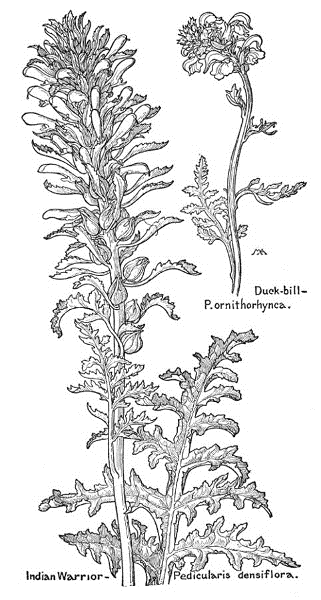
Duck-bill – P. ornithorhynca.
Indian Warrior – Pedicularis densiflora.
Alpine Betony
Pediculàris centranthèra
Magenta and white
Spring
Utah, Ariz., New Mex.
This grows in dry rocky soil at high altitudes, forming a low clump of pretty bronze-colored leaves, cut into many small crinkled lobes, and giving the effect of stiff little ferns, with a short spike of oddly pretty flowers, each over an inch long, with a purplish, hairy calyx and a corolla with a white tube and magenta lips, the anthers projecting like sharp little teeth from under the arching upper lip. P. semibarbàta, growing in dry woods in Yosemite, forms a rosette of crinkled bronze foliage, with short spikes of yellow flowers.
Elephants' Heads, Butterfly-tongue
Pediculàris Groenlándica
Pink
Summer
West, etc.
A handsome plant, with quaint flowers. The smooth, slender, purplish stem is a foot or more tall, with a few alternate leaves, and springs from a cluster of smooth, fern-like foliage, much like that of P. ornithorhyncha, often tinged with bronze, and bears a long, crowded spike of many flowers. They are slightly fragrant, about three-quarters of an inch long, with purplish calyxes and deep pink or reddish corollas, which look absurdly like little elephants' heads. This grows in the mountains, across the continent.
BROOM-RAPE FAMILY. Orobanchaceae
A rather small family, resembling Scrophulariaceae, widely distributed; parasitic herbs, without green foliage, with alternate scales instead of leaves; flowers perfect, irregular; calyx five-cleft, or split on one or both sides; corolla two-lipped; stamens four, in pairs, with slender filaments, on the corolla-tube (sometimes also the rudiment of a fifth stamen); ovary superior, style slender, stigma disk-like, with two or four lobes; fruit a capsule.
There are several kinds of Thalesia.
One-flowered Cancer-root
Thalèsia uniflòra (Orobanche)
Purplish
Spring, summer
Northwest, Utah, etc.
A queer little thing, but pretty and delicate, with a very short stem, mostly underground, bearing one or more slender, slightly hairy, dull yellow, scaly flower-stems from three to eight inches tall, each with a single flower, less than an inch long, with a dull yellow, hairy calyx, and a hairy, lilac corolla, tinged with dull yellow and veined with purple, with two yellow ridges in the throat. This is not common and is found across the continent.
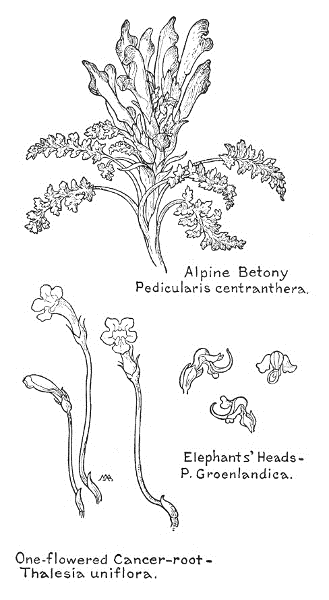
Alpine Betony – Pedicularis centranthera.
Elephants' Heads – P. Groenlandica.
One-flowered Cancer-root – Thalesia uniflora.
MADDER FAMILY. Rubiaceae
A large family, widely distributed, chiefly tropical. Ours are herbs, or shrubs; leaves opposite or in whorls; flowers regular, usually perfect; calyx with four teeth or none; corolla with four or five united lobes, often hairy inside; stamens on the corolla, as many as its lobes and alternate with them; ovary inferior, with one or two styles; fruit a capsule, berry, or stone-fruit. Coffee, Quinine, and Madder, used for dye, belong to this family. I am told that the latter plant is escaping around Salt Lake and is well established there. The Latin name means "red."
There are many kinds of Houstonia, North American, usually growing in tufts, leaves opposite; flowers small; calyx four-lobed; corolla funnel-form or salver-form, four-lobed; style slender, with two long stigmas; fruit a capsule. Sometimes the flowers are perfect, but usually they are of two kinds, one kind with high anthers and short pistil, the other kind with long pistil and anthers inside the corolla-tube; visiting insects carry pollen from the high anthers of the one to the high stigmas of the other, and from the low anthers to the low stigmas, thus ensuring cross-pollination.
Desert Innocence
Houstònia rùbra
Pink and white
Summer
Arizona
A pretty little desert plant, about two inches high, forming close tufts of sage-green foliage, like harsh moss, with stiff needle-like leaves and woody stems, sprinkled with charming little pink and white flowers. The corolla is three-eighths of an inch across, with a long slender tube, the stamens lilac, and the odd little nodding capsules have two round lobes. This grows in the dreadful sandy wastes of the Petrified Forest.
Kelloggia
Kellóggia galioìdes
Spring, summer
White, pink, yellowish
West, etc.
The only kind, a slender little plant, from six inches to a foot tall, usually with smooth leaves, with small stipules. The tiny flowers are white, pink, or greenish-yellow, with a bristly calyx, and the corolla usually has four petals, but sometimes five or three; the stigmas two. The fruit is covered with hooked bristles. This grows in mountain woods, as far east as Wyoming.
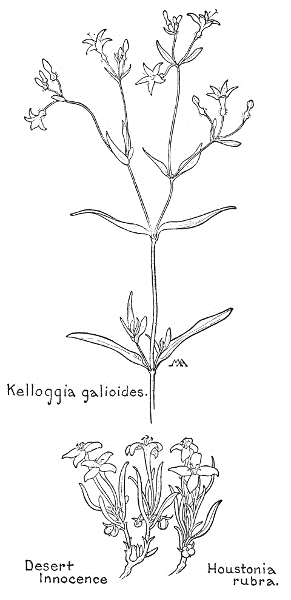
Kelloggia galioides.
Desert Innocence – Houstonia rubra.
There are many kinds of Galium, widely distributed; sometimes shrubs; stems square; leaves in whorls, without stipules; flowers small, usually perfect, in clusters; calyx usually with no border; corolla wheel-shaped, four-lobed; stamens four, short; ovary two-lobed; styles two, short, with round-top stigmas; fruit dry or fleshy, consisting of two similar, rounded parts, each with one seed. The common name, Bed-straw, comes from a tradition that the manger of the Infant Christ was filled with these plants. Other names are Goose-grass and Cleavers.
Northern Bed-straw
Gàlium boreàle
White
Summer
Northwest, etc.
A rather attractive, smooth, perennial, with a stout, leafy stem, sometimes branching, and the leaves in fours, with three veins, the margins sometimes rough and hairy. The small flowers are white and so numerous as to be quite pretty. The fruit is small, at first bristly, but smooth when ripe. This grows in northern mountains across the continent, also in Europe and Asia, up to ten thousand feet.
VALERIAN FAMILY. Valerianaceae
Not a large family, widely distributed, most abundant in the northern hemisphere; herbs, with opposite leaves and no stipules; flowers usually perfect, rather small, in clusters; the calyx sometimes lacking, or small, but often becoming conspicuous in fruit; corolla somewhat irregular, tube sometimes swollen or spurred at base, lobes united and spreading, usually five; stamens one to four, with slender filaments, on the corolla, alternate with its lobes; ovary inferior, with one to three cells, only one containing an ovule, the others empty; style slender; fruit dry, not splitting open, containing one seed.
There are many kinds of Valerianella, much alike, distinguished principally by their fruits.
Corn-salad
Valerianélla macrosèra (Plectritis)
Pink
Spring, summer
Northwest, Cal.
This has a juicy stem, from a few inches to over a foot tall, springing from a clump of smooth, very bright green leaves, and bearing most of the flowers at the top, in a small close cluster, with narrow purplish bracts. They are tiny, with a slightly irregular corolla, light pink, with two tiny crimson dots on each side of the lowest lobe, three dark brown anthers, and a calyx without a border. This is rather pretty, growing in long grass in damp places, but the flowers are too small to be effective.
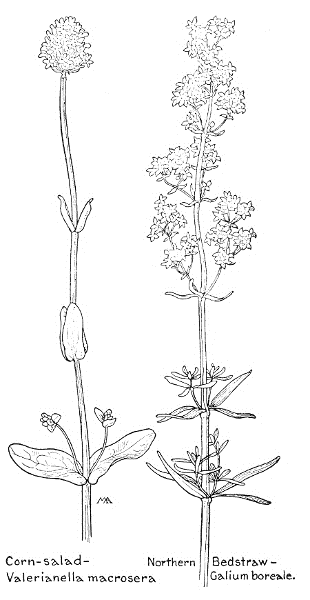
Corn-salad – Valerianella macrosera.
Northern Bedstraw – Galium boreale.
There are many kinds of Valerian, rather tall perennials, chiefly of cool regions and some in the Andes. They are more or less bad-smelling plants, especially the root; the leaves mostly from the base and the small flowers in terminal clusters, some of them perfect, some with stamens and pistils on separate plants, some with the two sorts mixed; the calyx with from five to fifteen bristle-like teeth, curled up and inconspicuous in flower, but spread out and feathery in fruit; the corolla white or pink, more or less funnel-form, with five nearly equal lobes; the stamens three; the style sometimes with three minute lobes. The name is from the Latin, meaning "strong," in allusion to the medicinal properties.
Wild Valerian
Valeriàna sitchénsis
White, pinkish
Summer
Wash., Oreg.
A very handsome and attractive plant, much like the kind that is cultivated in gardens. It grows from one to three feet tall, from a creeping rootstock, with smooth, juicy, hollow stems and handsome bright green foliage. The leaves are smooth and the leaflets of the stem-leaves are coarsely toothed. The flowers are white or pinkish, with pink buds, and are crowded in fine large, rather flat-topped clusters. The stamens are long and give a pretty feathery appearance to the cluster. The flowers are strongly sweet-scented, but the roots usually have a horrible smell when they are broken. V. sylvática looks much the same, but the leaves are mostly toothless, and it is widely distributed in the United States, both East and West, also growing in Asia. Both are woodland plants, liking rich moist soil.

